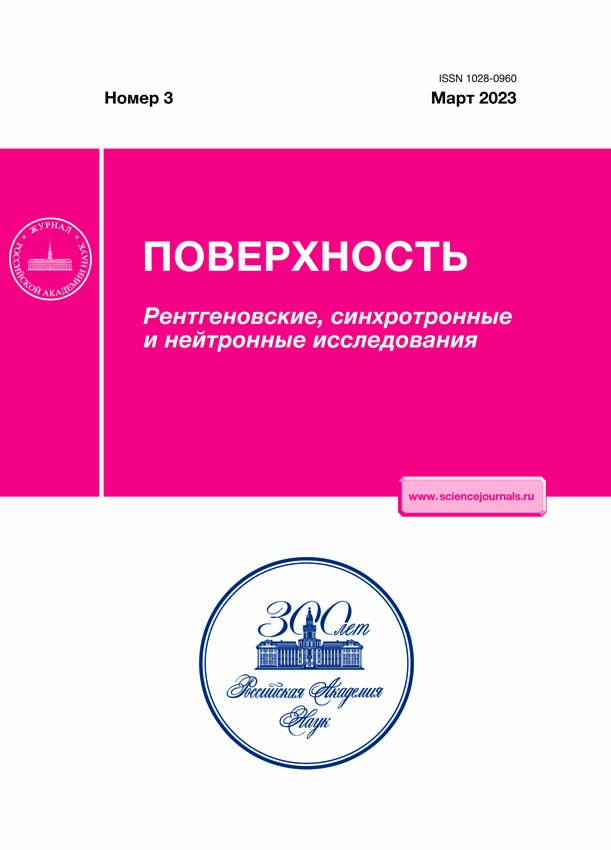Modification of the Properties of the Surface Layers of Aluminum Alloys under the Action of a High-Power Ion Beam
- Authors: Panova T.V.1, Kovivchak V.S.1
-
Affiliations:
- Dostoevsky Omsk State University
- Issue: No 3 (2023)
- Pages: 16-22
- Section: Articles
- URL: https://freezetech.ru/1028-0960/article/view/664590
- DOI: https://doi.org/10.31857/S1028096023030135
- EDN: https://elibrary.ru/LFQVRH
- ID: 664590
Cite item
Abstract
The effect of a high-power ion beam of nanosecond duration on the stress-strain state of the surface layer of aluminum and its alloys was studied. The data of elemental and phase analysis, residual stresses, sizes of coherent scattering regions and dislocation density were compared with the microhardness value for different irradiation regimes. A decrease in the lattice parameters of the α-phase of aluminum with an increase in the ion current density was found, which indicated the deforming effect of the resulting compressive residual stresses during irradiation with a high-power ion beam. The analysis of the sizes of the coherent scattering regions in alloys compared with pure aluminum showed a tendency to their decrease; in the D16 alloy the grinding occurred by a factor of 1.5, the dislocation density increased by a factor of two, and in the V95T alloy, the dislocation density increased by a factor of three. This trend indicates a significant influence of alloying elements on the dispersion and density of dislocations with varying irradiation parameters.
About the authors
T. V. Panova
Dostoevsky Omsk State University
Author for correspondence.
Email: panovatv@omsu.ru
Russia, 644077, Omsk
V. S. Kovivchak
Dostoevsky Omsk State University
Email: panovatv@omsu.ru
Russia, 644077, Omsk
References
- Ремнев Г.Е., Тарбоков В.А., Павлов С.К. // Физика и химия обработки материалов. 2021. № 2. С. 5. https://doi.org/10.30791/0015-3214-2021-2-5-26
- Грибков В.А., Григорьев В.И., Калин Б.А., Якушин В.Л. Перспективные радиационно-пучковые технологии обработки материалов. М.: Круглый год, 2001. 528 с.
- Модифицирование и легирование поверхности лазерными, ионными и электронными пучками / Ред. Поута Дж.М. и др. М.: Машиностроение, 1987. 423 с.
- Ремнев Г.Е., Погребняк А.Д. // Новости науки и техники. Сер. Новые материалы, технология их производства и обработки. М.: ВИНИТИ, 1990. 30 с.
- Ремнев Г.Е., Погребняк А.Д., Исанов И.Ф. и др. // Физика и химия обработки материалов, 1987. Вып. 6. С. 4.
- Чистяков С.А., Халиков С.В., Яловец А.П. // ЖТФ. 1993. Т. 63. № 1. С. 31.
- Ковивчак В.С., Панова Т.В. // Поверхность. Рентген., синхротр. и нейтрон. исслед. 2018. № 8. С. 69. https://doi.org/10.1134/S0207352818080115
- Шеметев Г.Ф. // Алюминиевые сплавы: составы, свойства, применение. Учебное пособие по курсу “Производство отливок из сплавов цветных металлов”. Ч. I. Санкт-Петербург, 2012. С. 16.
- Аброян И.А., Андронов А.Н., Титов А.И. Физические основы электронной и ионной технологии. М.: Высшая школа, 1984. 320 с.
- Комаров Ф.Ф. Ионная имплантация в металлы. М.: Металлургия, 1990. 216 с.
- Блейхер Г.А., Кривобоков В.П., Пащенко О.Б. // Изв. вузов. Физика. 1997. № 2. С. 67.
- Фень Л.Ц., Ремнев Г.Е., Салтымаков М.С. и др. // Изв. вузов. Физика. 2007. Т. 50. № 1. С. 66.
- Коротаев А.Д., Тюменцев А.Н., Третьяк М.В. и др. // Физика металлов и металловедение. 2000. Т. 89. № 1. С. 54.
- Бойко В.И., Валяев А.Н., Погребняк А.Д. // УФН. 1999. Т. 169. № 11. С. 1243.
- Ремнев Г.Е. // Изв. Томского политех. ун-та. 2000. Т. 303. № 2. С. 59.
- Чернов И.П., Белоглазова П.А., Березнеева Е.В. и др. // ЖТФ. 2015. Т. 85. Вып.7. С. 95.
- Панова Т.В., Ковивчак В.С. // Поверхность. Рентген., синхротр. и нейтрон. исслед. 2019. № 11. С. 94. https://doi.org/10.1134/S10280 96019110177
- Ковивчак В.С., Панова Т.В., Михайлов К.А. // Поверхность. Рентген., синхротр. и нейтрон. исслед. 2017. № 4. С. 95. https://doi.org/10.7868/S0207352817040126
- Ковивчак В.С., Панова Т.В., Михайлов К.А., Князев Е.В. // Письма в ЖТФ. 2013. Т. 39. Вып. 1. С. 11.
- Панова Т.В., Ковивчак В.С., Докучаев К.А. // Поверхность. Рентген., синхротр. и нейтрон. исслед. 2014. № 3. С. 48. https://doi.org/10.7868/S0207352814030196
Supplementary files














